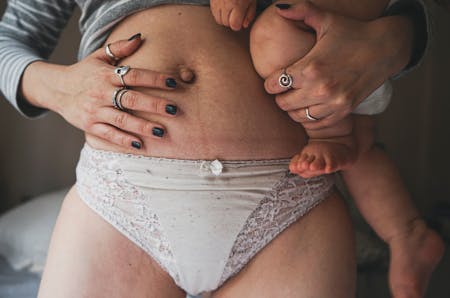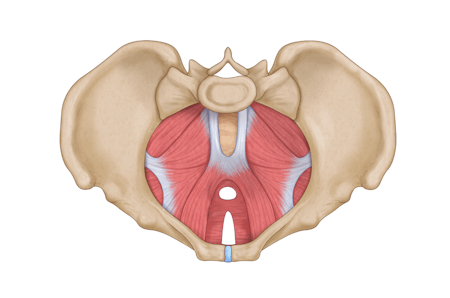PostpartumPregnancyDiastasis Rectus Abdominus
Diastasis Rectus Abdominis (DRA) also termed diastasis recti is becoming a hot topic among postpartum women and social media sources. However, with the discussions have come a lot of misconceptions and misleading information. In this article I am going to answer your questions and set things straight.
1. WHAT IS DIASTASIS RECTUS ABDOMINIS (DRA)?
During pregnancy the linea alba, connective tissue running down the centre of your abdomen, thins and expands as the baby grows. Most abdomens accommodate this stretch very well. As the linea alba expands it creates a vertical gap between your rectus abdominis (6 pack muscles.) This is a necessary and naturally occurring process during all pregnancies.
Another analogy is thinking of the linea alba adapting much like the cervix when you are having a baby. Your cervix is designed to thin out and dilate. In the same sort of way, the linea alba tissue is meant to thin out to accommodate a growing baby but after birth is meant to return to normal.
In most women connective tissue closes the gap in the first 6 weeks after childbirth, but for up to 32%-53% of women this closure does not occur. This gap is referred to as Diastasis Rectus Abdominis (DRA), also commonly referred to as diastasis recti, or “mummy tummy.” It persists when there is a dysfunction of your deep core, internal pressure system, and overstraining of the linea alba.
2. IS DRA PAINFUL?
Pain is not often associated with diastasis recti. In fact, in one study published in 2015, postpartum low back pain was similar (27%) in those with and without DRA.
3. HOW DO I KNOW IF I HAVE DRA?
If you see any doming or coning in the midline of your abdomen, this is diastasis recti. This doming is demonstrated in the second of the two side by side photos below. The doming often becomes pronounced and can be more easily observed when sitting up in bed, lifting your head while lying on your back (as if you were performing a crunch), during a plank, or while doing a double leg lift.
The two photos below are examples and typical presentations of two individuals with DRA. However for others, DRA may cause you to look 4 months pregnant or bloated all the time.
If you are concerned that you may have a DRA, come see me at Pelvic Health & Physiotherapy. It is best to be properly assessed by a physiotherapist with training in the screening and treatment for DRA. There are specific tests that can be performed to confirm whether a DRA is present however these tests can be very difficult to do on yourself.
4. IS THERE TREATMENT?
There is no time frame on healing DRA, so whether you are 8 weeks postpartum or 8 years postpartum, treatment can still be effective. Physiotherapy can help prevent further separation and expedite the closure of the gap between these muscles. Specific education and exercises catered to the individual and their symptoms can help improve the appearance, strength, and function of the abdomen and core. It is important to address DRA, as your abdominals work with your pelvic floor. Diastasis recti can make your pelvic floor less efficient, contributing to prolapse and incontinence. It’s also recommended that you be assessed prior to returning to sports or the gym, especially if you plan to return around the 6- 8 week mark, to ensure the connective tissue has closed the gap. Otherwise some exercises and lifting techniques can prevent the healing or create dysfunction in the internal pressure system resulting in incontinence and prolapse. A physiotherapist trained in postpartum fitness and exercise prescription can also help navigate you towards exercises to first begin with when returning to the gym and which ones to defer until later. At Pelvic Health & Physiotherapy I work with you to achieve your goals by teaching you the signs and symptoms to watch for that indicate when you are ready to progress to a more challenging exercise and when and how to modify others.
5. A WORD OF CAUTION AND SOME ADVICE
As moms we discourage our daughters from comparing their bodies to those of celebrities and models in magazines and on the internet, so why don’t we hold ourselves to the same standard? Many of us at 6 weeks postpartum start looking at our bodies in the mirror with despair and, might I say, sometimes with disgust. We compare ourselves to the fitness stories of success popping up on our screens.
Beauty, fitness, and fashion industries financially count on our vulnerability and dissatisfaction with our postpartum bodies. In angst we are often lured into purchasing intense postpartum boot camps and beach body ready fitness regimes on the web promising to get rid of our mummy tummies in 6 weeks or less. For a few individuals, these programs may be appropriate and result in the changes they desire. For many, their core and pelvic floor are unable to meet the demands of the fitness program, often resulting in bulging of the abdomen, incontinence and sometimes prolapse.
Please be aware that there is no governing body holding web-based programs accountable to the promises they make, the proclamations they claim, or the results they guarantee you. The DRA fixes that pop up in your Facebook newsfeed always show a picture of a woman when she was pregnant and then her “postpartum body.” How do we know that was not a picture of her in her early 20s before she had kids? They are so quick to show the fabulous results their programs offer, but I have yet to see in their advertising pictures of them when they had a DRA. Where is the proof that they ever had an unresolving diastasis recti postpartum? DRA programs market and often profit off of fear.
Next time you see a bikini shot of Beyonce 8 weeks after giving birth to twins, remember that celebrities can afford a full-time nanny, night-time nurse/nanny, makeup & hair stylist, personal trainer, cook, and plastic surgery.
Carrying a child in your womb as it grows and develops is nothing short of miraculous. See this video (https://www.instagram.com/p/BhtZCQPFnup/) for a quick 5 second clip of some changes to your organs to accommodate a growing baby. Mom, give yourself some grace. Having a baby changes us in every way. Why wouldn’t that include our bodies? Continue to love the children you created and gave life to! In return, love the person your children have helped you become both emotionally and physically.
Lynn Sweeney, Physiotherapist
BSc. Kin, MPT



